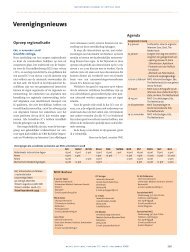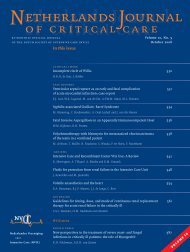Netherlands Journal of Critical Care
Netherlands Journal of Critical Care - NJCC
Netherlands Journal of Critical Care - NJCC
Create successful ePaper yourself
Turn your PDF publications into a flip-book with our unique Google optimized e-Paper software.
<strong>Netherlands</strong> <strong>Journal</strong> <strong>of</strong> <strong>Critical</strong> <strong>Care</strong><br />
later cortical waveforms (P45, N60 and P/N100) are less reliable<br />
and more susceptible to changes by sedation, the N20 is used in all<br />
prognostic clinical routines.<br />
The N20 SSEP in Prognostication<br />
Postanoxic Coma<br />
Bilateral absence <strong>of</strong> short latency (N20) SSEP response has been<br />
identified as the most powerful predictor <strong>of</strong> poor outcome in<br />
patients who are unconscious after circulatory arrest 1 . In patients<br />
not treated with hypothermia, bilateral absence <strong>of</strong> cortical N20<br />
responses 24 hours or more after the ischemic event is a reliable<br />
predictor for a poor neurological outcome 5,6,7 . A systematic review<br />
<strong>of</strong> Robinson showed a false positive rate (FPR) <strong>of</strong> 0% 6 , while a meta<br />
analyse <strong>of</strong> Wijdicks et al. found a 0.7% false positive rate for bilateral<br />
absent N20 responses in those patients 7 .<br />
In patients treated with therapeutic hypothermia, absence <strong>of</strong> the<br />
N20 also indicates a poor prognosis. In two large prospective studies,<br />
including 228 patients, the median nerve SSEP was found to be a<br />
reliable tool to predict a poor outcome after rewarming with an FPR<br />
<strong>of</strong> 0% 8,9 . However, a retrospective study <strong>of</strong> Leithner in 122 available<br />
SSEPs revealed one patient treated with therapeutic hypothermia<br />
after cardiac arrest with bilateral absent N20 responses at day 3<br />
with good neurological outcome 10 . This SSEP was measured on day<br />
3 under sedation with midazolam and fentanyl in a patient with<br />
alcoholic polyneuropathy. Despite this single case, pooled analysis<br />
<strong>of</strong> these three recent studies 8,9,10 on cardiac arrest patients after<br />
hypothermia still give very low FPRs <strong>of</strong> 0.9%, indicating that bilateral<br />
absence <strong>of</strong> the N20 should still be viewed as a reliable predictor for<br />
poor outcome in patients treated with hypothermia.<br />
Figure 1. The anatomical connections evaluated by the median nerve SSEP<br />
Thalamus<br />
Cuneate<br />
nucleus<br />
Postcentral<br />
gyrus<br />
Recent studies show that already during the period <strong>of</strong> hypothermia<br />
the SSEP is a reliable tool to predict a poor outcome 9,11,12,13 . A pooled<br />
analysis <strong>of</strong> these four prospective studies (424 patients), shows an<br />
FPR <strong>of</strong> 1.5% with a sensitivity <strong>of</strong> 28%. The FPR <strong>of</strong> 1.5% results from<br />
three patients with good neurological outcome and bilateral absent<br />
N20 responses during hypothermia, who were reported in the study<br />
<strong>of</strong> Bouwes et al 9 . However, in a post hoc assessment <strong>of</strong> these SSEP<br />
registrations it was concluded that these three SSEP recordings<br />
were undeterminable because there was too much noise in the<br />
registration 9 . Correction <strong>of</strong> these results led to an FPR <strong>of</strong> 0%.<br />
Unfortunately, preservation <strong>of</strong> the N20 does not imply a favourable<br />
outcome in patients after cardiac arrest. In fact, only a small proportion<br />
<strong>of</strong> patients with a poor outcome after resuscitation have negative SSEP<br />
responses resulting in a low sensitivity. This low sensitivity <strong>of</strong> the SSEP<br />
is also reflected in the large variability <strong>of</strong> EEG patterns that can be<br />
observed in patients with a preserved N20, including status epilepticus<br />
or even electro-cerebral silence 4 . As pyramidal cell synaptic function<br />
is mainly reflected by the EEG, while SSEP mainly evaluates the<br />
thalamocortical synaptic function, a possible explanation is selective<br />
hypoxic damage to the cortical pyramidal cells’ synaptic function, with<br />
preserved thalamocortical synapses 4 .<br />
Traumatic Brain Injury<br />
In patients with severe traumatic brain injury (TBI), the results<br />
available on the reliability <strong>of</strong> SSEP to predict outcome have been<br />
contradictive. Sleigh et al. showed in a prospective blinded cohort<br />
study including 105 patients that the median nerve SSEP is a reliable<br />
predictor for poor neurological outcome, with a 43% sensitivity and no<br />
false positives 14 . In contrast, in several other studies TBI patients were<br />
described with initially bilateral absent N20 responses who regained<br />
consciousness and had only minor disabilities 1,15,16 . These results show<br />
that absence <strong>of</strong> cortical SSEP responses is not a reliable predictor in<br />
TBI patients. The most likely explanation is that in head trauma, a<br />
transient N20 disappearance may be consecutive to focal midbrain<br />
dysfunction due to oedema 1 . Therefore, SSEPs should never be used as<br />
a single test in TBI patients, but integrated with other neurophysiologic<br />
tools and clinical examination to improve the predictive value 1,14,15 . In<br />
TBI patients it is especially important to rule out traumatic lesions <strong>of</strong><br />
the peripheral nerves, nerve roots or spinal cord when using clinical<br />
neurophysiologic tests. Clinical examination <strong>of</strong> the peripheral nerves<br />
can be difficult in patients with a diminished consciousness.<br />
Median<br />
nerve<br />
Lower<br />
brainstem<br />
Spinal cord<br />
Subarachnoid haemorrhage<br />
In patients with subarachnoid haemorrhage, neither median or tibial<br />
nerve SSEP, flash-visual evoked potential, BAEP nor central conduction<br />
time <strong>of</strong> the median nerve SSEP can be used as a valid predictor for<br />
outcome. The patient’s initial clinical grading still provides the only<br />
satisfying predictor, independent <strong>of</strong> the patient’s clinical course 17 .<br />
Sepsis<br />
In patients with severe sepsis and septic shock, prolonged cortical<br />
SSEP peak latencies occur in 84% <strong>of</strong> the patients. These prolonged<br />
6 Neth j crit care – volume 17 – no 1 – february 2013







